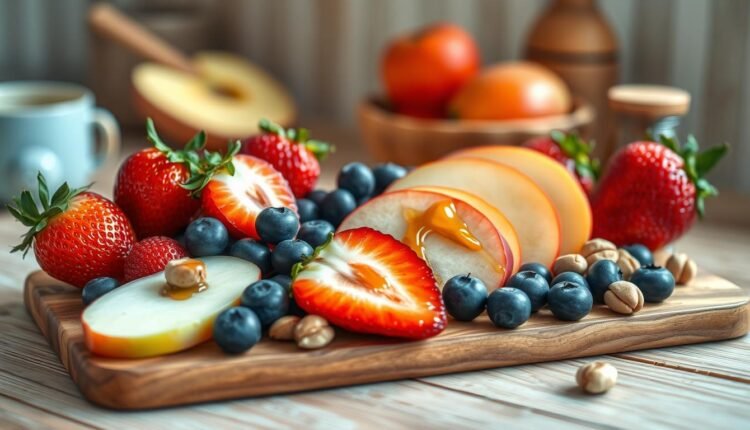Low Sugar Breakfast Seasonal Fruits For Maximum Flavor
Start your day with our curated list of low sugar breakfast seasonal fruits. Find the freshest picks for a nutritious breakfast.
I’ve lost count of how many times I’ve rushed through breakfast only to crash by mid-morning. That’s why I started leaning into nature’s candy—ripe, vibrant picks that satisfy sweet cravings without the rollercoaster effect. The secret? Choosing fruits at their peak season means they’re bursting with flavor naturally, so you don’t need added sweetness to make mornings exciting.
While all fruits contain natural sugars, some pack more fiber and nutrients to balance things out. Think juicy berries with a tart kick or crisp pears that add texture to yogurt bowls. These gems deliver vitamins C and K, antioxidants, and slow-digesting carbs to fuel your day. Plus, they’re surprisingly versatile—toss them into oatmeal, blend into smoothies, or layer over whole-grain toast.
Want to make these ingredients work for busy schedules? My seasonal meal prep guide shows how to wash, chop, and store them so you’re set for quick morning assembly. Let’s rethink breakfast—one delicious, nourishing bite at a time.
Key Takeaways
- Seasonal picks offer maximum flavor with minimal natural sugars
- High-fiber options help maintain steady energy levels
- Simple prep methods save time without sacrificing nutrition
Introduction to Low Sugar Breakfast Seasonal Fruits
Ever notice how a muffin or cereal leaves you foggy by 10 AM? I learned the hard way that starting with smart morning choices makes all the difference. Fresh picks at their peak aren’t just tastier—they’re packed with nutrients that processed options can’t match.
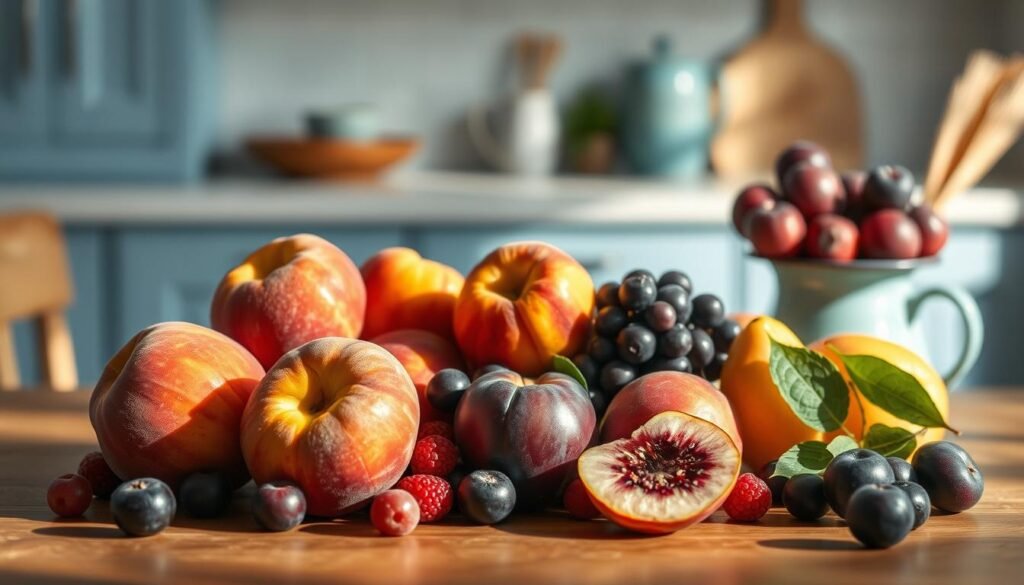
Take strawberries: a cup delivers 149% of your daily vitamin C with just 7 grams of natural sweetness. Compare that to a flavored yogurt, which often has 20+ grams of added sugars. Whole foods balance energy because fiber slows digestion. For example, raspberries offer 8 grams of fiber per cup—that’s 32% of your daily goal!
| Fruit (1 cup) | Grams Sugar | Key Nutrients |
|---|---|---|
| Strawberries | 7g | Vitamin C, manganese |
| Grapefruit | 9g | Vitamin A, potassium |
| Raspberries | 5g | Fiber, vitamin K |
Portion control matters too. A half-cup of blackberries has just 3.5 grams sugar but provides 35% of your vitamin K needs. This approach lets you enjoy natural sweetness without spiking blood sugar. Plus, you’ll get antioxidants that protect cells—something refined carbs lack entirely.
In this guide, we’ll explore how to build meals around these ingredients. You’ll learn measuring tricks (like using grams for accuracy) and creative ways to pair tart citrus with creamy avocado toast. Let’s make mornings work for you, not against you.
Why Choose Low Sugar Fruits for Breakfast?
Let me share a kitchen confession: I used to drizzle honey on everything until I realized nature already perfected sweetness. Whole fruits deliver satisfying flavor with built-in nutrients that refined sugars can’t match. This matters because what you eat first thing sets your energy trajectory for hours.
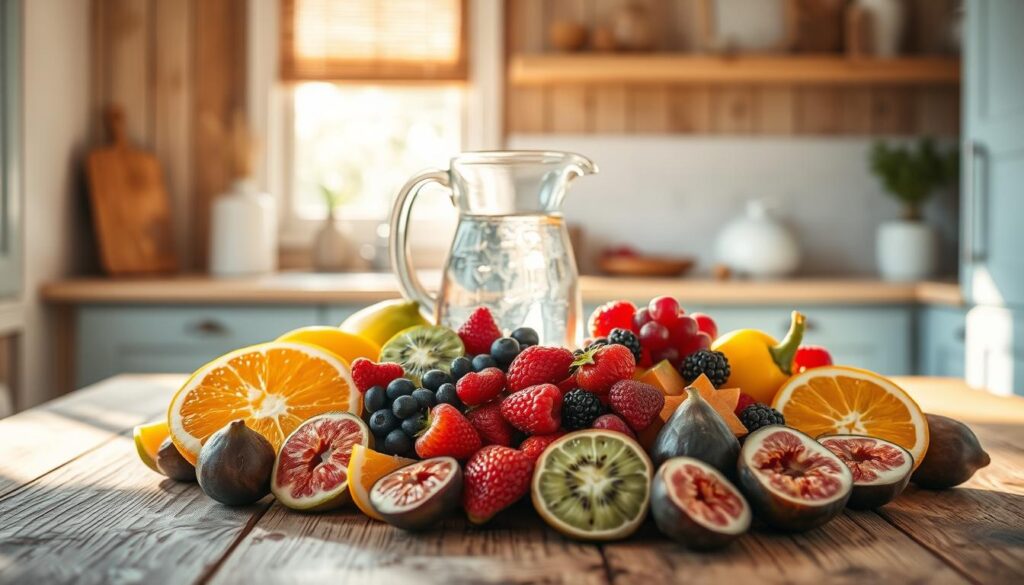
Health Benefits and Nutritional Impact
Citrus and berries shine here. A tablespoon of fresh lemon juice has just 0.6 grams of natural sugar but packs 10% of your daily vitamin C. Compare that to a cereal bar averaging 12 grams of added sweeteners. The fiber in these whole foods slows digestion, preventing energy crashes. Studies show diets rich in high-fiber options may lower type 2 diabetes risk by up to 30%.
Sugar Content Comparison with Processed Options
Portion-for-portion, whole foods outsmart packaged snacks every time. Check how they stack up:
| Food Item | Sugar per Serving | Key Nutrients |
|---|---|---|
| Lemon (1 medium) | 1.5g | Vitamin C, folate |
| Raspberries (1 cup) | 5g | Fiber, manganese |
| Flavored Oatmeal Packet | 14g | Added sugars, artificial flavors |
Notice how processed picks triple the sweetness without delivering nutrients? Even “healthy” granola often contains 8+ grams of added sugar per serving. By focusing on whole ingredients, you get antioxidants like quercetin and vitamin E that protect cells—bonuses you won’t find in syrup-laden alternatives.
Building balanced morning meals starts with this awareness. Pair tart fruits with proteins like Greek yogurt to further stabilize blood sugar. Your taste buds—and pancreas—will thank you.
Key Nutrients in Low Sugar Fruits
Picture this: you’re halfway through your morning meeting when hunger hits like a freight train. That’s when the magic of smart ingredient choices shines. The right combo of fiber, vitamins, and antioxidants keeps energy steady while delivering serious nutrition.
Fiber, Vitamins, and Essential Minerals
Fiber teams up with water in your digestive system to slow sugar absorption. Take raspberries—one cup offers 8 grams of fiber (32% daily needs) alongside 54% of your vitamin C. Cantaloupe cubes deliver 120% of your daily vitamin A in a single serving. Check how these stack up:
| Ingredient (1 cup) | Fiber | Key Nutrient |
|---|---|---|
| Blackberries | 7g | Vitamin K |
| Kiwi | 5g | Potassium |
| Grapefruit | 2g | Vitamin C |
Antioxidants and Their Role
Those vibrant colors in berries? Thank anthocyanins—antioxidants shown to reduce inflammation. A study in the Journal of Nutrition found adults eating 1.5 cups of blueberries daily improved blood vessel function within weeks. These compounds protect cells while supporting immune health.
Portion control matters. A measured cup of diced melon provides 50 calories plus hydration from its 90% water content. This balance makes it easy to enjoy natural sweetness without overdoing it. Pair with protein-rich Greek yogurt for lasting satiety.
When choosing ingredients, prioritize high-fiber options with bold colors. They’re nature’s multivitamins—delivering nutrients your body actually uses. Your energy levels (and taste buds) will notice the difference.
Detailed Look: low sugar breakfast seasonal fruits
There’s nothing worse than starting your day with a burst of energy only to hit a wall before lunch. The solution? Knowing which ingredients deliver flavor without the crash. A true “low-sugar fruit” typically contains ≤10 grams of natural sugar per serving while packing fiber and essential nutrients.
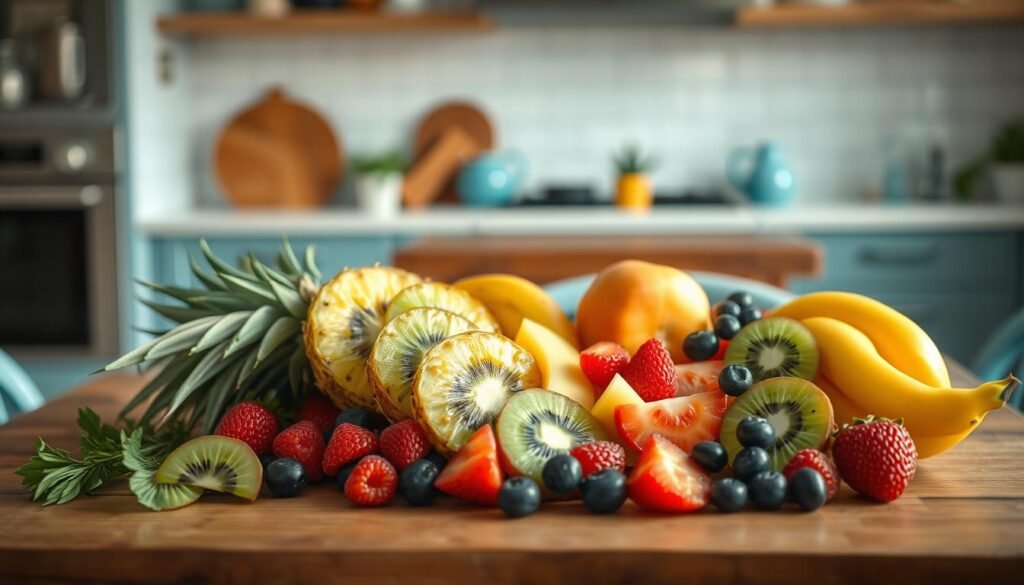
| Ingredient (1 cup) | Natural Sugar | Fiber |
|---|---|---|
| Raspberries | 5 grams | 8g |
| Blackberries | 7 grams | 7g |
| Grapefruit | 9 grams | 2g |
These gems shine in savory-sweet morning salads. Try tossing spinach with grapefruit segments and avocado—the fat helps slow sugar absorption. Or layer berries over cottage cheese with mint for a refreshing twist.
Why does this work? The fiber in these options (like raspberries’ 8g per cup) balances their natural sweetness. Pair them with proteins or healthy fats for meals that keep you full without spiking glucose. For quick ideas, explore our low-sugar breakfast recipes that turn these ingredients into grab-and-go jars or hearty bowls.
Pro tip: Prep citrus segments or berry mixes the night before. Toss them into Greek yogurt, fold into chia pudding, or add crunch to almond butter toast. It’s nutrition that adapts to your morning rhythm—not the other way around.
Seasonal Citrus Options for a Tangy Start
Remember that puckery face you made as a kid biting into a lemon wedge? Turns out, that zing packs serious morning benefits. Bright, acidic flavors wake up your taste buds while delivering nutrients without overwhelming sweetness.
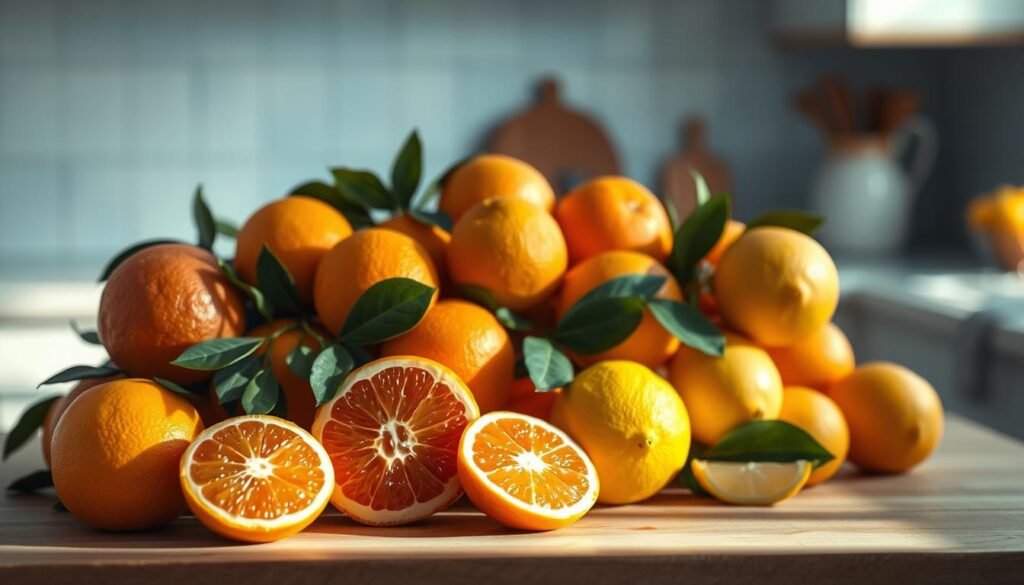
Lemons, Limes, and Grapefruit Highlights
Let’s talk numbers. One medium lemon contains just 1.5 grams of natural sweetness “per fruit” while providing 30mg of vitamin C—half your daily needs. Limes are even leaner at 1 gram per fruit. Their tartness works magic in dressings or infused water.
| Citrus Type | Sugar (Per Fruit) | Vitamin C | Best Uses |
|---|---|---|---|
| Lemon | 1.5g | 30mg | Zest over oats, mix in herbal tea |
| Lime | 1g | 19mg | Drizzle on avocado toast, blend into chia pudding |
| Grapefruit | 9g | 38mg | Broil with cinnamon, toss in spinach salads |
Grapefruit deserves its spotlight. Though slightly higher in natural sugars, half a fruit fits neatly into a balanced “diet”. Its bitter notes pair beautifully with creamy textures like ricotta or almond butter.
These citrus fruits are “also good” for hydration. Try freezing lime wedges in ice cubes for sparkling water. Or whip up a 3-ingredient dressing: lemon juice, olive oil, and Dijon mustard.
Pro tip: Segment grapefruit the night before. Layer it with mint and walnuts for a grab-and-go parfait. Tangy mornings never tasted this refreshing.
Berries: A Sweet and Low-Sugar Treat
There’s a quiet rebellion happening in my kitchen against overly sweet mornings. Berries became my go-to allies, offering bold flavors without tipping the sweetness scale. Their vibrant hues signal a powerhouse of nutrients—fiber to keep you full, antioxidants to fight inflammation, and just enough natural sweetness to satisfy cravings.
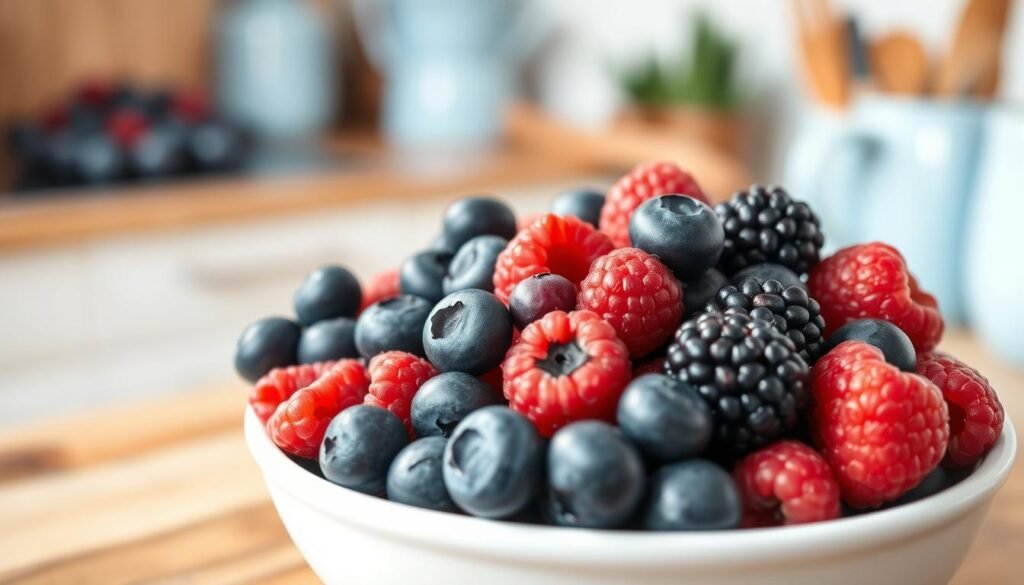
Raspberries and Strawberries Profile
Raspberries are the unsung heroes of the berry world. One cup contains only 5 grams of natural sugars paired with 8 grams of fiber—that’s like eating a candy bar that cleans up after itself. Strawberries follow closely, delivering 3 grams of fiber per cup alongside 149% of your daily vitamin C. Try swirling them into chia pudding or layering with Greek yogurt for a protein-packed parfait.
| Berry (1 cup) | Natural Sugars | Key Benefits |
|---|---|---|
| Raspberries | 5g | 32% daily fiber |
| Strawberries | 7g | Immune-boosting vitamin C |
Blackberries and Other Varieties
Blackberries bring earthy depth to morning meals. With 7 grams of sugar per cup and a hefty dose of vitamin K, they’re perfect for tossing into spinach salads or blending into smoothies. Explore lesser-known types like boysenberries or marionberries for nuanced flavors—their tartness balances creamy ingredients like cottage cheese or almond butter.
Pro tip: Freeze extra berries in single-serving bags. They’ll thicken smoothies naturally while preserving nutrients. Morning nourishment shouldn’t feel complicated—sometimes, nature’s candy is all you need.
Exotic Picks: Kiwis and Avocados
Let’s talk about two ingredients that changed my morning routine: velvety avocados and zippy kiwis. While they might seem unconventional, these gems bring gourmet flair to simple meals while keeping sweetness in check.
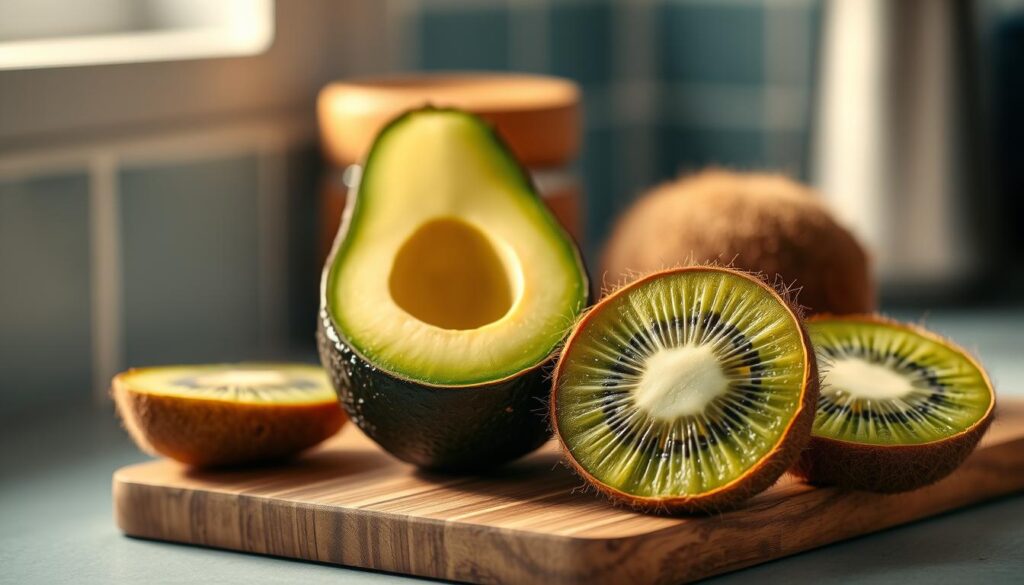
Nutritional Spotlight on Avocados
A whole avocado contains just 1 gram of natural sugars but delivers 21 grams of heart-healthy fats. Here’s how they compare to their tropical counterpart:
| Fruit (1 whole) | Natural Sugars | Healthy Fats | Fiber |
|---|---|---|---|
| Avocado | 1g | 21g | 13g |
| Kiwi | 6g | 0.3g | 2.3g |
Avocados shine as a creamy base for savory toasts or smoothies. Their monounsaturated fats help absorb nutrients like vitamin E from spinach. One reader told me:
“Mashing avocado with lime juice onto rye bread became my go-to—it’s filling without that heavy feeling.”
Kiwis pack a punch too. Two fruits provide 230% of your daily vitamin C—more than oranges! Their tartness balances well with creamy ingredients. Try layering sliced kiwi over cottage cheese with chia seeds.
Both offer antioxidants like lutein (avocados) and quercetin (kiwis) that support eye and immune health. A small portion elevates oatmeal or yogurt bowls into something special. Don’t be afraid to experiment—these ingredients reward creativity.
Melons and Stone Fruits for Variety
Ever sliced into a ripe melon and felt instantly refreshed? These juicy picks bring hydration and subtle sweetness to morning meals. With 90% water content, they’re nature’s edible hydration boost—perfect for hot days or post-workout fuel.
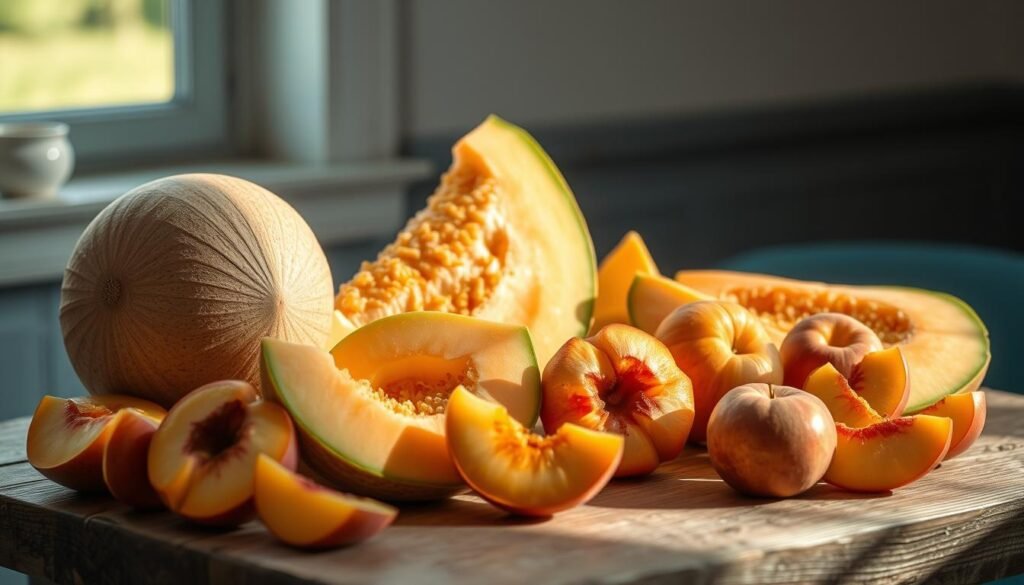
Cantaloupe and Watermelon Essentials
One cup of diced cantaloupe contains 8 grams of natural sugars and 120% of your daily vitamin A. Watermelon shines with just 9 grams per cup plus lycopene—an antioxidant linked to heart health. Try these combinations:
| Fruit (1 cup) | Natural Sugar | Key Vitamin | Water Content |
|---|---|---|---|
| Cantaloupe | 8g | A (120%) | 90% |
| Watermelon | 9g | C (14%) | 92% |
Peaches and Oranges Overview
Stone fruits add velvety texture. A medium peach has 13 grams of sugar but delivers 3 grams of fiber. Oranges provide 70mg vitamin C per fruit—ideal for immune support.
Build vibrant salads by layering watermelon cubes with mint and feta. Or blend frozen peaches into yogurt bowls. One reader shared:
“Mixing cantaloupe balls with lime zest transformed my morning routine—it’s like sunshine in a bowl!”
Measure portions using a kitchen scale for accuracy. A 150-gram serving balances flavor and nutrition without overwhelming sweetness. These varieties prove that smart choices can be both practical and exciting.
Balancing Sugar and Nutrients in Your Diet
Last Tuesday, I watched a client pile watermelon onto her oatmeal until it resembled a fruit avalanche. We chuckled, then had a lightbulb moment: even nature’s candy needs boundaries. Smart enjoyment means savoring flavors while respecting your body’s needs.
Moderation and Serving Sizes
The average American consumes 17 teaspoons of added sugar daily—triple the recommended 6 teaspoons for women. Whole foods help, but intake still matters. Here’s how popular choices stack up:
| Food | Actual Sugar | Ideal Portion |
|---|---|---|
| Grapes | 23g/cup | ½ cup |
| Mango | 22g/cup | ¾ cup |
| Pineapple | 16g/cup | 1 cup |
Source: USDA Dietary Guidelines | *Portions adjusted for diabetes risk
Pair tart berries with almond butter or full-fat yogurt. The fats slow digestion, preventing blood sugar spikes. One reader shared:
“Measuring my morning blueberries helped me avoid afternoon crashes—it’s simple math, not deprivation.”
For those monitoring diabetes risk, try the “two-fist” method: one fist-sized fruit portion, plus protein. This way balances energy without guesswork.
The benefits? Steadier focus and reduced inflammation. In addition, controlled intake supports long-term metabolic health. Next, we’ll explore creative ways to blend these principles into grab-and-go meals.
Practical Tips for Incorporating These Fruits into Your Breakfast
Let me tell you about the morning I discovered raspberries could jazz up scrambled eggs. The key? Treating them like flavor boosters rather than just toppings. With smart pairings and prep tricks, you’ll turn these ingredients into kitchen MVPs without morning chaos.
Recipe Ideas and Creative Combos
Start with a bulletproof smoothie: blend frozen raspberries (5g sugar per cup), spinach, and almond milk with a scoop of collagen. Add chia seeds for extra fiber—it’s like a nutrition hug for your gut. For savory lovers, fold diced strawberries into omelets with goat cheese. The tartness cuts through richness beautifully.
Try these chef-approved swaps:
- Layer blackberries and walnuts over cottage cheese for crunch
- Toss grapefruit segments into kale salads with avocado
- Freeze kiwi slices as edible “spoons” for Greek yogurt
Meal Planning and Preparation Strategies
Sunday prep changed my game. Wash and dry berries immediately—they’ll last 5 days in glass jars. Portion cantaloupe into snack bags for grab-and-go parfaits. One reader managing diabetes shared:
“Pre-measuring ½ cup strawberry portions helped me enjoy sweetness without glucose spikes.”
| Meal Component | Fiber Boost | Sugar Control Tip |
|---|---|---|
| Oatmeal Toppings | Add flaxseed | Use ¼ cup raspberries |
| Yogurt Mix-ins | Chia seeds | Pair with almonds |
For busy weeks, my freezer-friendly guide shows how to batch-prep smoothie packs with measured berries. Balance is everything—combine sweet ingredients with proteins or fats to slow sugar absorption. Your energy levels (and taste buds) will notice the difference.
Conclusion
Let’s revisit the essentials: building a smarter morning routine starts with intentional ingredient choices. Nutrient-packed options like raspberries (5g sugar per cup) and grapefruit (9g per fruit) deliver vibrant flavors while supporting steady energy. Measuring portions in grams or cups helps manage intake without sacrificing enjoyment.
Balancing your diet isn’t about restriction—it’s about pairing fiber-rich fruits with proteins or healthy fats. This combo slows sugar absorption, keeping blood sugar levels stable. For example, a handful of blackberries tossed into Greek yogurt adds texture and 7g of fiber.
Every choice matters. Prioritize fruits with bold colors and high water content—they’re nature’s multivitamins. Explore creative combinations, like layering kiwi over almond butter toast or blending frozen mango into chia pudding. For more inspiration on balancing flavor and nutrition, explore our guide to the best fruits to eat in the.
Your plate is your playground. Experiment with confidence, knowing each bite fuels your day without hidden sugars. We’d love to hear how you’re reinventing your plate—share your creations with us!

